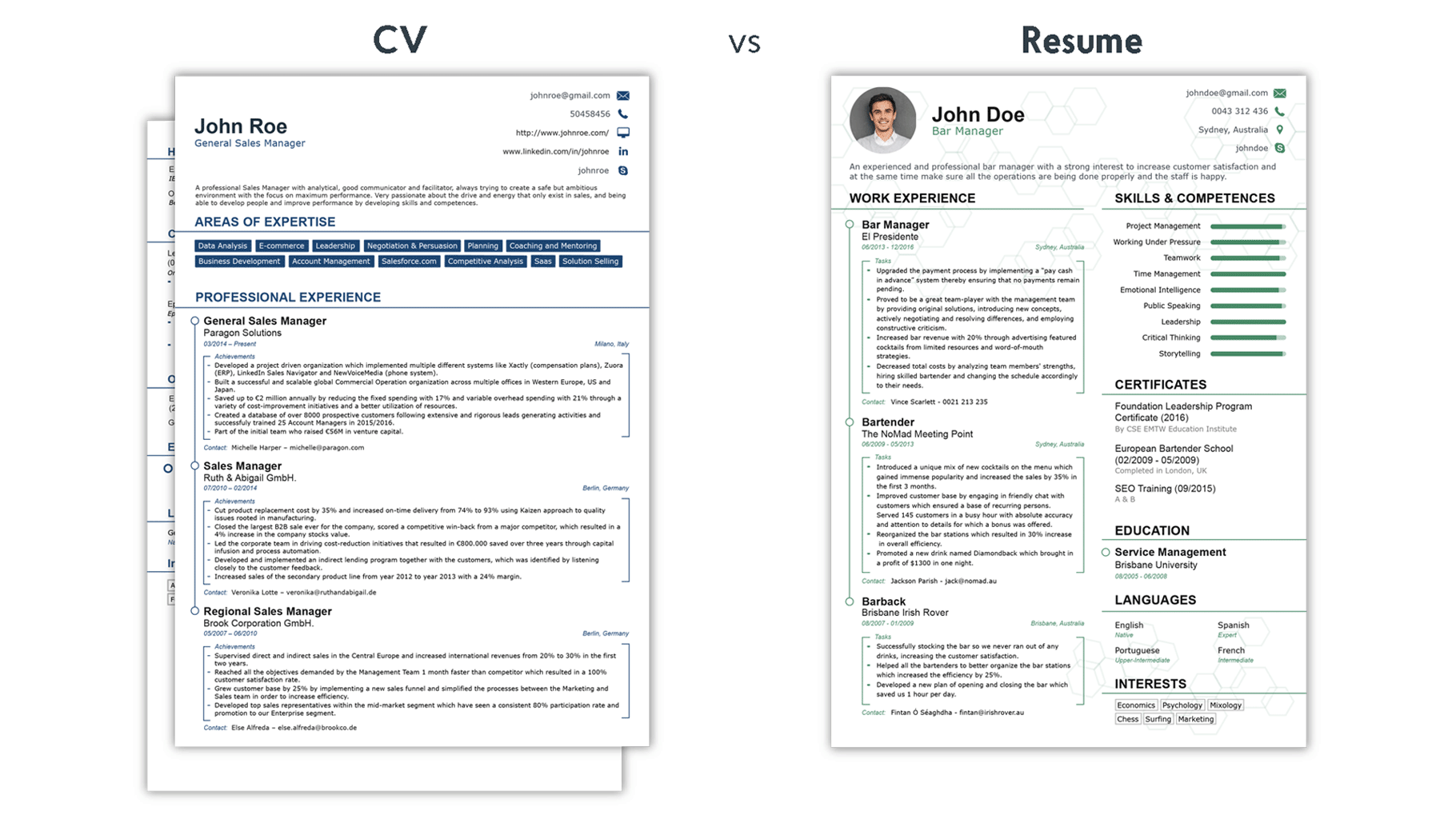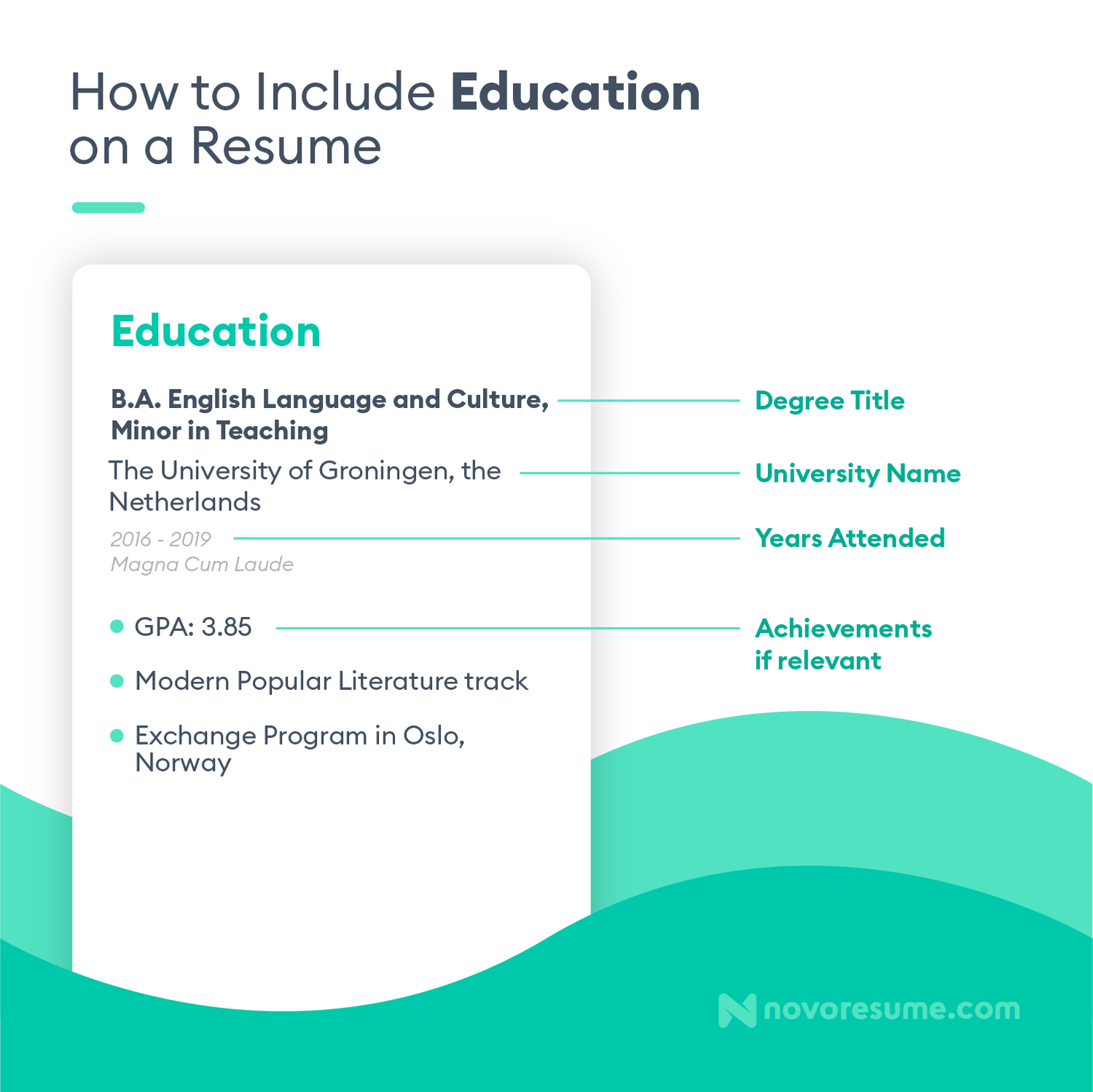At first glance, there’s nothing profound or too complicated about listing education on your resume.
You insert all the schools you have ever attended in chronological order, and bam, you’re done.
Easy, right?
Well, let me ask a (hint: tricky!) question:
Do you list education before work experience if you are still in school but also have worked a bit?
Not sure?
How about:
Should you still list your GPA next to your education entry when all you did in college was skip classes, drink, and swipe right on Tinder?
Yeah, we know you’ve got your stuff together now and want to get everything right.
So read on and we’ll answer both those questions and more!
- Where exactly to position education on your resume
- How to list education on your resume [+ Template]
- Specific real-life examples on how to list:
- High school education
- GED certificate
- University degree
- Associate’s degree
- Certificates
- Graduate school degree
- Unfinished education
Where to Position Education On Your Resume

So, should your education or experience come first in your resume?
Think of it this way:
The top third of the resume is reserved for your accomplishments that are most relevant to the job you are applying for.
So before you continue, ask yourself: Is your education your most relevant accomplishment?
The answer most of the time will be no. Work experience will be a more important requirement for just about any position above entry-level.
However, education can take priority in some particular cases.
Education comes first if you’ve just graduated from college and don’t have relevant work experience to list. Imagine you are an employer and the first thing you see in someone’s resume when they’re applying for an entry-level marketing associate position is their summer job as a bodyguard at their local town pool.
It’s also wise to list education before work experience if you’ve recently gotten back to school to get a degree that’s relevant to your potential job.
For example, if you’re switching to a career in sustainable energy after having finished a related program, but have work experience predominantly in engineering, you would want your new education to be the first thing the hiring manager sees.
Getting a fresh MSc, Ph.D., or MBA is another case where you would want to highlight those degrees more than the work experience.
An example would be if you’ve been a line manager for several years but went back to school to get an MBA and are reaching for that executive position. The deciding committee would want to see your MBA first and then your experience as a line manager.
Be careful if you are applying for a job in Academia and are writing a CV instead of a resume though. In that case, your education always comes before the work experience.
Not sure if you need a CV or a resume? Check out our guide on CV vs Resume and learn what’s the difference between the two (and when to use which).

How to Put Down Your Education in Your Resume [+ Template]
Now that you have an idea of where to put your education section, let’s start with the basics.
In terms of structuring your education section, the general practice is to follow a reverse chronological order: list your latest educational entry first, and then go backwards from there.
Okay, but how far back should you go? Do you put your high school education in there as well?
Usually, if you have a relevant university degree, it’s not advisable to waste precious space on your resume by listing your high school education.
Now that we’ve got all of that out of the way, we can show you a general template of how to write down your education. You list the following features in this particular order:
- Name of degree (Minor - optional): e.g. B.A. English Language and Culture, Minor in Teaching*
- Name of educational institution: e.g. University of Groningen
- Years attended: e.g. 2016 - 2019
- Location of the program (optional): e.g. Groningen, the Netherlands
- GPA (optional): e.g. 3,84. Keep in mind, though, that you only list education if it’s at an “impressive” scale (i.e. 3.5+). This shows determination and hard work on your part. If it’s lower, you might want to omit it altogether.
- Honors (optional): e.g. Magna Cum Laude
- Courses that are relevant to the job (optional): e.g. Modern Popular Literature track
- Exchange programs (optional): e.g. Exchange Program in Oslo, Norway
- Bachelor of Arts in English Language and Culture with a Minor in Teaching
- B.A. English Language and Culture (Major), Teaching (Minor)
- BA, English Language and Culture
The full listing for this educational entry, then, is:

Of course, as we mentioned, many of these entries are optional. Listing all of them like ingredients for a recipe makes the resume look a bit cluttered. It’s going to be up to you to decide which ones are relevant for the job you are applying to.
For example, if our Jane Doe was applying for a librarian position at a local bookstore, her entry would look much shorter:
EDUCATION
B.A. English Language and Culture, Minor in Teaching
University of Groningen
2014 - 2017
3,84 GPA
The only useful information for this position would be what, where, and when she studied. Notice how that would change if the position was at an international bookstore and one of the requirements was a “global mindset”:
EDUCATION
B.A. English Language and Culture, Minor in Teaching
University of Groningen
2014 - 2017
3,84 GPA
Exchange Program in Oslo, Norway
Jane would now mention her exchange program since it’s relevant directly to her job position, which requires some sort of international experience.
- If you graduated from a famous university with a good reputation, you might want to highlight that first if you think it will make a good impression. So you would list “Harvard University” before the name of the degree.
As you can see, there’s plenty of freedom on how you decide to list your education. The main thing is to keep it short, relevant, and consistent throughout the resume.
13+ Examples of Listing Education on Your Resume
In this section, we’ll give you a clearer idea of how to list your education on your resume, through practical examples for all types of education.
Feel free to skip through the examples that don’t apply to you.
How to List High School Education & GEDs on Your Resume
If you’re a student in high school, the chance is you probably have some volunteer work and extracurriculars under your belt. If these aspects are relevant to the job you are applying for, you can put them before the education section.
In all other cases, the education section would take the upper hand, and would look something like this:
EDUCATION
Chapel Hill High School
2013-2017
3,56 GPA
Courses: AP Science, Mathematics, Advanced Chemistry
If you’re still in high school, you can list it in your resume by omitting the finishing year
EDUCATION
Chapel Hill High School
2017 - Present
3,56 GPA
If you were homeschooled or haven’t graduated high school but still received a General Education Development certificate, you can mention that in your resume in the following way:
EDUCATION
GED High School Diploma
Durham Literacy Center
2017
Note here that you can also add relevant courses or the location of your high school or GED center if you see it fit and you have enough space.
How to List Undergraduate Education on Your Resume
We already gave you an example of how to list a Bachelor’s Degree in the previous section.
Here’s how you would, for example, list an engineering degree in three different cases.
If you have already finished university and have gotten the degree, list it according to the following template:
EDUCATION
B.Sc. Mechanical Engineering
University of California, Berkeley
2002 - 2006
If you obtained a double major, you would write it down as:
EDUCATION
B.Sc. in Mechanical Engineering and Civil Engineering
University of California, Berkeley
2002 - 2006
3,90 GPA
Keep in mind, though, If you have two or more majors, you would want to list the major that is most relevant to the job you are applying to.
If you’re still attending college, though, you omit the finishing year, by adding “Present” instead:
EDUCATION
B.Sc. in Mechanical Engineering and Civil Engineering
University of California, Berkeley
2019 - Present
You can use other words & phrases instead of Present, as well, such as:
- Expected Graduation + year (So 2019 - 2023)
- In progress
- To be Completed + year.
And if you did go to university but realized frozen pizzas and ramen noodles weren’t your thing and dropped out, you can still list your unfinished education in your resume:
EDUCATION
University of California, Berkeley
34 credits completed towards B.Sc. in Civil Engineering
2018 - 2019
How to List Community College Education on Your Resume
You list community college education pretty much the same way as any other undergraduate degree.
The rules we explained on how to mention that you’re still studying or dropped out also apply here.
Now, let’s look at some real-life examples of different types of degrees.
Graduated with an Associate of Arts degree from a community college:
EDUCATION
AA. in Business Designation, Summa Cum Laude
Community College of Denver
2015 - 2016
In pursuit of an Associate’s of Applied Science degree in a community college:
EDUCATION
AAS. in Medical Assisting
Community College of Denver
2018 - Present
A certificate from a community college:
EDUCATION
Community College of Denver
30 credits completed towards a Medical Assisting Certificate
2015
How to List Graduate Level Education on Your Resume
Graduate-level education is, in general, more detailed, since you have participated in a more focused area of research and graduate-level work.
You most probably have also put out a dissertation of your own, which you should include in your resume.
Often, there are scholarships, fellowships or outside funding involved, which you might want to include in addition to all the general information.
Here are some real-life examples:
EDUCATION
MBA in Business Administration
Magna Cum Laude
University of Maine
Avangrid Scholarship
2014
-----
EDUCATION
Ph.D. in Brain and Cognitive Sciences
University of Rochester
2018 - Present
Dissertation: Imaging, Computational Analysis, & Neural Representations in Young Children
-----
EDUCATION
MSc. in Information Systems
WU Vienna University of Economics & Business
Salutatorian, Summa Cum Laude
2015 - 2017
Dissertation: Leveraging User-Generated Content for Advertising Purposes Through Information Systems
There’s a lot more to creating a good resume than just the education section. Become an expert with our complete guide on how to write a resume.
Key Takeaways
Now, let’s wrap up everything we learned in this post:
- Your education section belongs under your work experience section. If you don’t have any work experience, or just want to fault that new degree, though, you can put it on top instead.
- When listing your educational entries, do it reverse-chronologically. Meaning, start with the most recent ones and go backward from there.
- If you have a university or community college degree, don’t list your high school education.
- If you don’t have an exceptional GPA, do not list it.
- There are many ways to list your education depending on the type of school you went to (scroll back up for the examples!).
- And finally, if you didn’t finish your education, you can still put it down on your resume.
In all, the best way to avoid making mistakes or forgetting something important when you list your education on your resume is to use a reliable resume builder.
Want to know how that looks like?
Novorésumé makes your life much easier by offering many free templates that you can fill out online.
It’s free, it’s reliable, and it can really make your resume shine.

And if there’s anything else you want to learn about the job hunt process, you can always check out our career blog for the latest news.
Suggested Reading:


